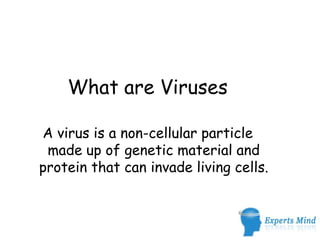What are viruses
•Download as PPTX, PDF•
1 like•1,463 views
http://www.expertsmind.com/biology/virus-homework-assignment-help.aspx
Report
Share
Report
Share

Recommended
Recommended
More Related Content
What's hot
What's hot (20)
Lect no.1 a introduction to virology-gen.prop and class

Lect no.1 a introduction to virology-gen.prop and class
Similar to What are viruses
Similar to What are viruses (20)
More from Expertsmind IT Education Pvt Ltd.
More from Expertsmind IT Education Pvt Ltd. (20)
Recently uploaded
APM Welcome
Tuesday 30 April 2024
APM North West Network Conference, Synergies Across Sectors
Presented by:
Professor Adam Boddison OBE, Chief Executive Officer, APM
Conference overview:
https://www.apm.org.uk/community/apm-north-west-branch-conference/
Content description:
APM welcome from CEO
The main conference objective was to promote the Project Management profession with interaction between project practitioners, APM Corporate members, current project management students, academia and all who have an interest in projects.APM Welcome, APM North West Network Conference, Synergies Across Sectors

APM Welcome, APM North West Network Conference, Synergies Across SectorsAssociation for Project Management
This presentation was provided by William Mattingly of the Smithsonian Institution, during the third segment of the NISO training series "AI & Prompt Design." Session Three: Beginning Conversations, was held on April 18, 2024.Mattingly "AI & Prompt Design: The Basics of Prompt Design"

Mattingly "AI & Prompt Design: The Basics of Prompt Design"National Information Standards Organization (NISO)
Recently uploaded (20)
9548086042 for call girls in Indira Nagar with room service

9548086042 for call girls in Indira Nagar with room service
Presentation by Andreas Schleicher Tackling the School Absenteeism Crisis 30 ...

Presentation by Andreas Schleicher Tackling the School Absenteeism Crisis 30 ...
IGNOU MSCCFT and PGDCFT Exam Question Pattern: MCFT003 Counselling and Family...

IGNOU MSCCFT and PGDCFT Exam Question Pattern: MCFT003 Counselling and Family...
Kisan Call Centre - To harness potential of ICT in Agriculture by answer farm...

Kisan Call Centre - To harness potential of ICT in Agriculture by answer farm...
APM Welcome, APM North West Network Conference, Synergies Across Sectors

APM Welcome, APM North West Network Conference, Synergies Across Sectors
social pharmacy d-pharm 1st year by Pragati K. Mahajan

social pharmacy d-pharm 1st year by Pragati K. Mahajan
Mattingly "AI & Prompt Design: The Basics of Prompt Design"

Mattingly "AI & Prompt Design: The Basics of Prompt Design"
Russian Escort Service in Delhi 11k Hotel Foreigner Russian Call Girls in Delhi

Russian Escort Service in Delhi 11k Hotel Foreigner Russian Call Girls in Delhi
Call Girls in Dwarka Mor Delhi Contact Us 9654467111

Call Girls in Dwarka Mor Delhi Contact Us 9654467111
Measures of Central Tendency: Mean, Median and Mode

Measures of Central Tendency: Mean, Median and Mode
Interactive Powerpoint_How to Master effective communication

Interactive Powerpoint_How to Master effective communication
Web & Social Media Analytics Previous Year Question Paper.pdf

Web & Social Media Analytics Previous Year Question Paper.pdf
What are viruses
- 1. What are Viruses A virus is a non-cellular particle made up of genetic material and protein that can invade living cells.
- 2. Viruses – Are they Living Organisms? • Tiny (50-100nm) “non-cellular particles”. • Obligate, intracellular parasites: – Cannot reproduce on their own. – Cannot carry on metabolic processes. • Do have hereditary material?
- 3. Studying Viruses • Why? – Produce vaccines – Develop antiviral drugs – Used as vectors for molecular biology experiments – recombinant DNA studies.
- 4. Vaccines • Viruses grown on chicken embryos are attenuated vaccines • Another type of vaccine is made by heat killing the virus
- 5. Studying Viruses • Morphology – Genome – – Capsid – – Envelope – some have a phospholipid/ protein protective covering in addition to their capsid. Part viral part host in composition.
- 6. The Structure Of a Virus • Viruses are composed of a core of nucleic acid • The Nucleic acid core is surrounded by a protein coat called a capsid • The Nucleic core is either made up of DNA or RNA but never both
- 7. Nonenveloped virus Genome (in this case, DNA) Capsid (protein) Enveloped virus Genome (in this Viral protein case, RNA) Host protein Capsid (protein) Envelope (phospholipid bilayer)
- 9. General Features of Viruses #1 • Obligate Intracellular Parasites • Very small (ultramicroscopic) • Non-cellular • Not Alive • Protein Coat Capsid • Envelopes (some viruses..not all)
- 10. General Features of Viruses #2 • Utilization of Host Cell Machinery • Host Range • Genome • DNA or RNA but NOT both • Single stranded or double stranded • Enzymes (Polymerases) (some viruses…not all)
- 11. Virus Reproduction • General Replication cycle – requires a host cell:
- 12. Virus Reproduction • 2 types of replication cycles: – Lytic – following entry, replication and assembly, new virus particles exit the cell by rupturing the host cell membrane, often destroying the host cell,
- 13. Lytic Cycle
- 14. Studying Viruses • 2 Replication cycles cont’d – Lysogenic • Following entry, the viral genome is incorporated into the host cell genome. • As the host cell replicates its own genome the viral genome also is replicated and is passed on to daughter cells. • This phase may last years. • Usually some “trigger” will cause the host cell to enter a lytic phase.
- 15. Lysogenic cycle
- 16. How do Viruses Enter Cells? • Viruses may enter through an injured spot on a cell membrane/cell wall. • Viruses with envelopes may enter by endocytosis. • Many viruses prefer a certain kind of cell. – Recognize a specific membrane protein (receptor) on the cell membrane and bind to it. – Example: Influenza viruses bind to receptors in the respiratory tract only.
- 17. How do viruses enter cells? • In general, viruses without envelopes empty only their genome into cell while viruses with envelopes incorporate genome and capsid into cell (endocytosis).
